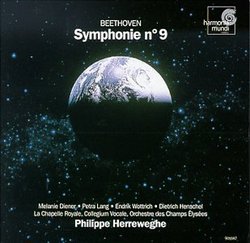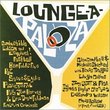| All Artists: Philippe Herreweghe, Melanie Diener, Petra Lang, Endrik Wottrich, Dietrich Henschel, La Chapelle Royale, Collegium Vocale, Orchestre Des Champs Elysees Title: Beethoven: Symphony no. 9 / Herreweghe, Orchestre Des Champs Elysees, et al Members Wishing: 1 Total Copies: 0 Label: Harmonia Mundi Fr. Release Date: 5/11/1999 Album Type: Import Genre: Classical Styles: Historical Periods, Classical (c.1770-1830), Symphonies Number of Discs: 1 SwapaCD Credits: 1 UPC: 794881464227 |
Search - Philippe Herreweghe, Melanie Diener, Petra Lang :: Beethoven: Symphony no. 9 / Herreweghe, Orchestre Des Champs Elysees, et al
 | Philippe Herreweghe, Melanie Diener, Petra Lang Beethoven: Symphony no. 9 / Herreweghe, Orchestre Des Champs Elysees, et al Genre: Classical
This is a handsomely played period-instruments version of the Ninth, joyous from the outset, with little italicizing or exaggeration. The articulation of the brass and woodwind is spotless and crisp without being what is o... more » |
Larger Image |
CD DetailsSynopsis
Amazon.com This is a handsomely played period-instruments version of the Ninth, joyous from the outset, with little italicizing or exaggeration. The articulation of the brass and woodwind is spotless and crisp without being what is occasionally (and derogatorily) called "Germanic." The second movement dances and the third is beautiful and songful, if decidedly without the gorgeous introspection one wants in it. The big melody of the 4th movement is flowing and rich and the light soloists (the bass is almost tenorish in timbre) are in keeping with the overall conception--and it's nice to be able to hear every thread of the vocal texture. What's wrong? Well, it all seems a bit bloodless--this is a work filled with mystery and cosmic implications, and you'd never guess it from hearing this. It's a beauty, to be sure, and musicians and those already familiar (and in love with) the Ninth will want to hear it for its cool, unexaggerated charm, but most will find it too clinical and just a bit shallow. --Robert Levine Similarly Requested CDs
|
CD ReviewsHerreweghe Interprets All Composers Nicely R. Gerard | Pennsylvania USA | 05/14/2006 (5 out of 5 stars) "Harmonia Mundi has a real knack for taking old, oft-recorded classics and breathing new life into them. This is largely thanks not only to HM's marvelous sound quality, but to the artists who the people at HM employ on the label's roster. For HM, Rene Jacobs has interpreted old-favorite Mozart operas with unmatched vitality, Konrad Junghanel has done it with Bach cantatas, Andrew Manze with Mozart's instrumental works, and Phillipe Herreweghe with the larger scale choral works of Bach. But what Herreweghe has done here with Beethoven prooves that he is capable of interpreting for any period, just like (if not better than) John Eliot Gardiner. Just like many other music students/enthusiasts, I have many recordings of Beethoven's Ninth Symphony, but none other has attracted my ear more than Herreweghe's, not even the classic Karajan on DG or the new Zinman on Arte Nova. Yes, Herreweghe uses period instruments, but the Orchestre Des Champs d'Elysees packs just as much punch as any full size symphony orchestra. Mr. Herreweghe really does keep things moving too, and takes full advantage of the orchestra's dynamics. While conductors like Zinman (who's interpretation I love nontheless) will utilize sheer speed to convey drama, Herreweghe really brings out the passion from each of his players. What I love most about Herreweghe's Ninth Symphony is the "Turkish" themed march in the middle of the fourth movement. The conductor's use of dynamics is excellent here, as the simple beat of cymbals and bass drums swells from pianissimo to forte, and becomes "high art" with full strings and chorus. Herreweghe thusly cannot be merely portrayed as an excellent conductor of sacred works, but as a real dramatist. Each vocal soloist is excellent and Herreweghe's choir remains my all-time favorite (they are just so uniform, and they sing from the heart, and not to be showy... "vom Herzen," as Beethoven often said). I am especially impressed with the tenor. I am so used to tenors singing the "Froh, wie seinen Sonne (etc..)" during the Turkish tinged march sounding the same and uninspired with each recording. But not here. Listen to it, and you'll see what I mean. Beethoven's score is beyond words, and Herreweghe's conducting really does it justice. Listen for yourself." Very good Arnout Koeneman | the netherlands | 09/10/2003 (5 out of 5 stars) "3 stars average? And the guy before me gave it only one star. ? This is without a doubt the best Beethoven 9, in my opinion ofcourse. This recording is breathtaking. My favorite piece of this symphony: the opening movement is at last given the right speed, drive and rhythm. I do not exaggerate when I claim that this is very likely the best possible way to perform this piece. Brilliant. Needless to say that the singing is excellent, what you'd expect from Herreweghe. Please do me a favour and listen to this disc, don't believe those editor remarks: the spirit and mystery is greatly served by Herreweghe." Finally! Beethoven can rest in peace now. V. Bouret | 05/27/1999 (5 out of 5 stars) "This is the one that I have been looking and waiting for all these years. Maestro Herreweghe's understanding of this music is so fresh and crisp it finally quenched my thirst. This recording brings 'joy' back into the Beethoven Symphony No 9. Listen to it and you will know what I am talking about."
|

 Track Listings (4) - Disc #1
Track Listings (4) - Disc #1




